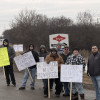Working on the manpower shortage are, l. to r., Roman Alaniz Jr., L-74 (Houston), recruiter for the Central States; Gary Evenson, AIP-Director Construction Recruitment Services; Christopher Hegeman, L-37 (New Orleans), recruiter for the Southeast; Bill Palmisano, MOST Administrator; and Anthony Smarra, Local 154 (Pittsburgh), recruiter for the Northeast. Not pictured is Brian Loftus, L-744 (Cleveland), recruiter for the Great Lakes.
MOST initiative helps contractors meet manpower challenge
“THERE ARE LOTS of people out there who would like to work for our signatory contractors. They just have to be asked.”
That assessment by Gary Evenson, AIP-Director-Construction Recruitment Services, sums up the purpose of the MOST recruitment program. Its aim is to find qualified nonunion welders and riggers, and connect them with Boilermaker locals and signatory contractors.
Manpower availability is a primary mission of MOST, which stands for Mobilization, Optimization, Stabilization, and Training. Created as a Taft- Hartley trust, the organization serves the interest of both the contractors and the Boilermakers union.
With a construction boom under way in heavy industry, nearly two million new craft workers will be needed in the United States in the next 10 years — yet the pool of skilled workers continues to shrink as baby boomers retire. MOST hopes to attract qualified nonunion workers to fill gaps where needed. Succeeding in this mission will help signatory contractors keep, and perhaps expand, their market share. It will also give locals an opportunity to evaluate potential new members — and grow their lodges.
Evenson, who spent more than a dozen years as a Boilermaker Fight Back organizer and led the formation of Local 4 in Page, Ariz., began directing the recruitment effort August 1. He oversees five recruiters, one in each of the five U.S. geographical jurisdictions of the International Vice Presidents. Evenson compiled figures through Nov. 20, 2007, showing that recruiters brought in about 500 nonunion craftsmen who went to work for signatory contractors. More than 2,000 workers have been added to the MOST reserve system database.
Director-Construction
Recruitment Services
“Most of the credit for our recruitment success goes to [MOST Administrator] Bill Palmisano and the recruiters,” says Evenson. “Bill got this program off the ground in November 2006. The numbers we’re talking about would add up to a good-size Boilermaker construction lodge.” MOST recruiters include Roman F. Alaniz Jr., Central States; Christopher Hegeman, Southeast Area; Brian Loftus, Great Lakes; and C. Anthony Smarra, Northeast Area. The recruiting slot for the Western States is in the process of being filled.
Evenson says it takes a special kind of person to be a recruiter. “You have to be comfortable meeting strangers, and not everybody can do that.” MOST recruiters explain the advantages of working for Boilermaker signatory contractors. Sometimes this can be a challenge, says Evenson. “There are some nonunion contractors who actually pay a higher daily rate and per diem than our union contractors, but they don’t offer benefits. Union contractors blow them out of the water when you consider the whole package — rate, per diem, and benefits.”
Still, many younger workers like the idea of maximizing what’s on the paycheck and don’t think ahead to the importance of health care coverage and a good pension.
“When I was younger,” Evenson recalls, “I was one of those guys who said just put the money for pension and health care on the paycheck. Boy, am I glad the older guys didn’t listen to me. When you’re 20, you think you’re going to live forever. By the time you’re in your 30s and have a family and children, health and welfare becomes a lot more important to you.
MOST Administrator
“I tell these young guys, ‘What you’re doing now is creating a road for life. You can make it a smooth ride, with your pension and health care taken care of, or a bumpy ride, without benefits. Believe me, when you’re 35 you’re going to say that the big old bald guy was right.’”
Ideally, the recruitment program brings in welders, riggers, and other qualified workers who have completed an apprentice program and have practical experience. Some recruits come directly from welding schools though. Locals may choose to provide recruits with safety and welding training; they may also enroll them in a Boilermaker apprenticeship.
One strategy to find recruits is to run local advertising about upcoming Common Arc testing at a local lodge. Nonunion workers who attend have an opportunity to be tested in various welding techniques and certified by signatory contractors.“Local 4 held Common Arc tests in January, and 13 contractors were present,” Evenson said. “Some two dozen nonunion workers participated, and most of them received certifications. We always have a good turnout and a high pass rate.”
Involvement by the lodges is crucial says MOST’s Palmisano. “It’s really a joint effort among the recruiters, MOST, and the lodges. MOST’s job is to find qualified people who do the kind of work we do. These people go into our reserve system.” Locals have the opportunity to draw on the reserve system when there are manpower shortages. They also have the opportunity to offer recruits union membership.
“Our recruiting effort is only a little over a year old,” says Palmisano, “but it’s been quite successful.”






